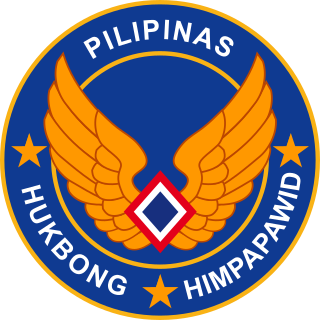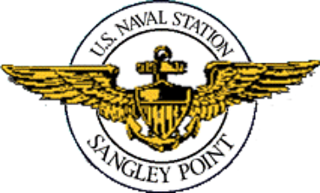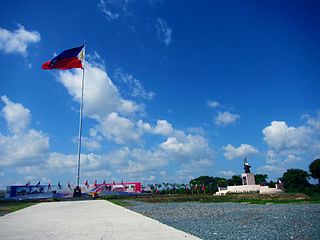| Cañacao Bay | |
|---|---|
Cañacao Bay is the body of water left of the Sangley Point airstrip. | |
| Location | Luzon Island, Philippines |
| Coordinates | 14°29′20″N120°51′06″E / 14.4889°N 120.8518°E Coordinates: 14°29′20″N120°51′06″E / 14.4889°N 120.8518°E |
| Type | bay |
| Part of | Manila Bay |
| Settlements | |
Cañacao Bay is a small bay located within the larger Manila Bay in Luzon island in the Philippines.

Manila Bay is a natural harbour which serves the Port of Manila, in the Philippines. Strategically located around the capital city of the Philippines, Manila Bay facilitated commerce and trade between the Philippines and its neighbouring countries, becoming the gateway for socio-economic development even prior to Spanish occupation. With an area of 1,994 km2 (769.9 sq mi), and a coastline of 190 km (118.1 mi), Manila Bay is situated in the western part of Luzon and is bounded by Cavite and Metro Manila on the east, Bulacan and Pampanga on the north, and Bataan on the west and northwest. Manila Bay drains approximately 17,000 km2 (6,563.7 sq mi) of watershed area, with the Pampanga River contributing about 49% of the freshwater influx. With an average depth of 17 m (55.8 ft), it is estimated to have a total volume of 28.9 billion cubic metres. Entrance to the bay is 19 km (11.8 mi) wide and expands to a width of 48 km (29.8 mi). However, width of the bay varies from 22 km (13.7 mi) at its mouth and expanding to 60 km (37.3 mi) at its widest point.

Luzon is the largest and most populous island in the Philippines. It is ranked 15th largest in the world by land area. Located in the northern region of the archipelago, it is the economic and political center of the nation, being home to the country's capital city, Manila, as well as Quezon City, the country's most populous city. With a population of 53 million as of 2015,, it is the fourth most populous island in the world containing 52.5% of the country's total population.

The Philippines, officially the Republic of the Philippines, is an archipelagic country in Southeast Asia. Situated in the western Pacific Ocean, it consists of about 7,641 islands that are categorized broadly under three main geographical divisions from north to south: Luzon, Visayas, and Mindanao. The capital city of the Philippines is Manila and the most populous city is Quezon City, both part of Metro Manila. Bounded by the South China Sea on the west, the Philippine Sea on the east and the Celebes Sea on the southwest, the Philippines shares maritime borders with Taiwan to the north, Vietnam to the west, Palau to the east, and Malaysia and Indonesia to the south.
It is located along the northeastern end of the Cavite Peninsula and Cavite City, in the Province of Cavite. [1]

The Cavite Peninsula is a peninsula extending northeast into Manila Bay from the coastal town of Noveleta in Cavite province in the Philippines. The northern tip of the peninsula is geographically the northernmost part of the Province of Cavite.

Cavite City, officially the City of Cavite,, is a 4th class city in the province of Cavite, Philippines. According to the 2015 census, it has a population of 102,806 people.
The Provinces of the Philippines are the primary political and administrative divisions of the Philippines. There are 81 provinces at present, further subdivided into component cities and municipalities. The National Capital Region, as well as independent cities, are independent of any provincial government. Each province is governed by an elected legislature called the Sangguniang Panlalawigan and by an elected governor.

The bay is a good anchorage and it is bordered to the north by the Danilo Atienza Air Base of the Philippine Air Force and by the Naval Base Cavite of the Philippine Navy to the south. Both military bases previously were comprised by the Naval Station Sangley Point of the United States.

Danilo Atienza Air Base is a military base used by the Philippine Air Force, located on the northern end of Cavite Peninsula in Manila Bay, Luzon Island, the Philippines. It is adjacent to Cavite City, in Cavite Province.

The Philippine Air Force is the aerial warfare service branch of the Armed Forces of the Philippines.

Naval Station Pascual Ledesma, also known as Cavite Naval Base or Cavite Navy Yard, is a military installation of the Philippine Navy in Cavite City in the Province of Cavite. The 9-hectare (22-acre) naval base is located at the easternmost end of Cavite Point in the San Roque district of the city. It was the former U.S. Naval Station Sangley Point, transferred to the Philippines in 1971. In 2009 it was named after Cmdre. Pascual Ledesma, a leader of the Philippine revolution and the first Officer-In-Command of the Philippine Navy.
The Cavite City Hall is on the south side of the bay, with a pier for public ferry service to Metro Manila.

Metropolitan Manila is the seat of government and one of the three defined metropolitan areas of the Philippines. It is officially known as the National Capital Region (NCR), and is commonly known as Metro Manila or simply Manila. It is made up of 16 cities namely: the City of Manila, Quezon City, Caloocan, Las Piñas, Makati, Malabon, Mandaluyong, Marikina, Muntinlupa, Navotas, Parañaque, Pasay, Pasig, San Juan, Taguig, and Valenzuela, as well as the municipality of Pateros.
The shore of the bay near the former Cavite Royal Arsenal was where the province's patron saint, an icon known as Our Lady of Solitude of Porta Vaga, was found during the Spanish colonial period following an alleged Marian apparition.

A patron saint, patroness saint, patron hallow or heavenly protector is a saint who in Roman Catholicism, Anglicanism or Eastern Orthodoxy, is regarded as the heavenly advocate of a nation, place, craft, activity, class, clan, family or person.

The history of the Philippines from 1521 to 1898, also known as the Spanish colonial period, was a period during which Spain controlled the Philippine islands as the Captaincy General of the Philippines, initially under New Spain until Mexican independence in 1821, which gave Madrid direct control over the area. It was also known as Spanish East Indies to the colonialists. It started with the arrival in 1521 of European explorer Ferdinand Magellan sailing for Spain, which heralded the period when the Philippines was a colony of the Spanish Empire, and ended with the outbreak of the Philippine Revolution in 1898, which marked the beginning of the American colonial era of Philippine history.

A Marian apparition is a reported supernatural appearance by the Blessed Virgin Mary. The figure is often named after the town where it is reported, or on the sobriquet given to Mary on the occasion of the apparition.
















